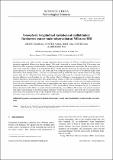| dc.contributor.author | Zhang, Shun-Rong | |
| dc.contributor.author | Coster, Anthea J | |
| dc.contributor.author | Holt, John M | |
| dc.contributor.author | Foster, John C | |
| dc.contributor.author | Erickson, Philip J | |
| dc.date.accessioned | 2016-10-21T17:23:39Z | |
| dc.date.available | 2016-10-21T17:23:39Z | |
| dc.date.issued | 2012-03 | |
| dc.date.submitted | 2012-01 | |
| dc.identifier.issn | 1674-7321 | |
| dc.identifier.issn | 1869-1900 | |
| dc.identifier.uri | http://hdl.handle.net/1721.1/104911 | |
| dc.description.abstract | Incoherent scatter radar (ISR) extra-wide coverage experiments during the period of 1978–2011 at Millstone Hill are used to investigate longitudinal differences in electron density. This work is motivated by a recent finding of the US east-west coast difference in TEC suggesting a combined effect of changing geomagnetic declination and zonal winds. The current study provides strong supporting evidence of the longitudinal change and the plausible mechanism by examining the climatology of electron density Ne on both east and west sides of the radar with a longitude separation of up to 40o for different heights within 300–450 km. Main findings include: 1) The east-west difference can be up to 60% and varies over the course of the day, being positive (East side Ne > West side Ne) in the late evening, and negative (West side Ne > East side Ne) in the pre-noon. 2) The east-west difference exists throughout the year. The positive (relative) difference is most pronounced in winter; the negative (relative) difference is most pronounced in early spring and later summer. 3) The east-west difference tends to enhance toward decreasing solar activity, however, with some seasonal dependence; the enhancements in the positive and negative differences do not take place simultaneously. 4) Both times of largest positive and largest negative east-west differences in Ne are earlier in summer and later in winter. The two times differ by 12–13 h, which remains constant throughout the year. 5) Variations at different heights from 300–450 km are similar. Zonal wind climatology above Millstone Hill is found to be perfectly consistent with what is expected based on the electron density difference between the east and west sides of the site. The magnetic declination-zonal wind mechanism is true for other longitude sectors as well, and may be used to understand longitudinal variations elsewhere. It may also be used to derive thermospheric zonal winds. | en_US |
| dc.description.sponsorship | National Natural Science Foundation (China) (Grant 40890164) | en_US |
| dc.description.sponsorship | National Science Foundation (U.S.) (Grants ATM-0733510 and ATM- 6920184) | en_US |
| dc.publisher | SP Science China Press | en_US |
| dc.relation.isversionof | http://dx.doi.org/10.1007/s11431-012-4784-y | en_US |
| dc.source | SP Science China Press | en_US |
| dc.title | Ionospheric longitudinal variations at midlatitudes: Incoherent scatter radar observation at Millstone Hill | en_US |
| dc.type | Article | en_US |
| dc.identifier.citation | Zhang, ShunRong et al. “Ionospheric Longitudinal Variations at Midlatitudes: Incoherent Scatter Radar Observation at Millstone Hill.” Science China Technological Sciences 55.5 (2012): 1153–1160. | en_US |
| dc.contributor.department | Haystack Observatory | en_US |
| dc.contributor.mitauthor | Zhang, Shun-Rong | |
| dc.contributor.mitauthor | Coster, Anthea J | |
| dc.contributor.mitauthor | Holt, John M | |
| dc.contributor.mitauthor | Foster, John C | |
| dc.contributor.mitauthor | Erickson, Philip J | |
| dc.relation.journal | Science China Technological Sciences | en_US |
| dc.eprint.version | Author's final manuscript | en_US |
| dc.type.uri | http://purl.org/eprint/type/JournalArticle | en_US |
| eprint.status | http://purl.org/eprint/status/PeerReviewed | en_US |
| dc.date.updated | 2016-08-18T15:46:53Z | |
| dc.language.rfc3066 | en | |
| dc.rights.holder | Science China Press and Springer-Verlag Berlin Heidelberg | |
| dspace.orderedauthors | Zhang, ShunRong; Coster, Anthea J.; Holt, John M.; Foster, John C.; Erickson, Phil | en_US |
| dspace.embargo.terms | N | en |
